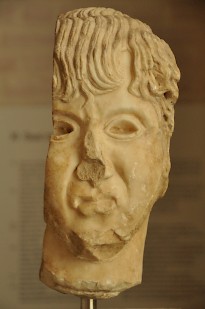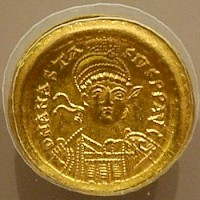Zosimus
Zosimus (Greek Ζώσιμος): Early Byzantine, pagan author of a history of the Roman Empire, published in the first quarter of the sixth century CE.
Life

Zosimus must have belonged to an important family: his parents could pay for an excellent education. Their son was well-read in Greek literature: in the New History, he refers to Herodotus of Halicarnassus, Thucydides, and Polybius of Megalopolis. The name "Zosimus" was not very common in the ancient world, but several Zosimi are known from Ascalon and Gaza, and we may assume that this is the area where Zosimus' family lived.
Zosimus was conservative in his outlook, continuing to believe in the ancient pagan gods, even though he lived during the reign of the emperor Anastasius (r.491-518), more than a century after Constantine (r.306-337) and Theodosius (r.378-395) had enabled the Empire’s Christianization. In his New History, Zosimus blames the rise of the new faith for the demise of the Roman world.
According to the ninth-century patriarch of Constantinople, Photius, an avid reader, Zosimus had served the Empire as a comes, a title used by several high-ranking officials. Photius does not refer to the precise nature of this office or to the city in which Zosimus served. He does mention, however, that the author had also been an ἀποφισκοσυνήγορος (a Greek rendering of Latin advocatus fisci), a financial office that required a juridical education. This may have brought the young man to Beirut, the most important law school in the Roman world. Zosimus' descriptions of Constantinople suggest that he has lived there as well.
The New History

It is often said that the New History was published in 518 and this may be true, but the proof is quite complex. It is known that another historian, Eustathius, used Zosimus as a source. Since Eustathius described the reign of Anastasius, and Byzantine historians rarely wrote about the reign of the ruling emperor, we can assume that Eustathius lived during the reign of Anastasius' successor Justin (r.518-527). Because Zosimus was Eustathius' source, it is most likely that he lived during the reign of Anastasius. This emperor abolished a tax that had been introduced by Constantine, the chrysargyron, in 498. Since Zosimus speaks about it in the past tense, we may assume that he wrote these lines after 498.note
All this would lead us to the conclusion that Zosimus wrote between 498 and 518, and while the first of these years is quite certain, the second one is based on the assumption that Byzantine historians did not write about ruling emperors, which is contradicted by, for example, Procopius. In any case: Zosimus wrote after 498 and appears to be unaware of the reconquests during the reign of Justinian, which strongly suggests a date in the first quarter of the sixth century.
The New History remained unfinished. There are several indications that Zosimus wanted to write more;note the text lacks final editing; it ends rather abruptly in the year 410, just before the sack of Rome. For a book that claims to offer a contemporary history (as indicated by the title), this is curious, and we may wonder what Zosimus’ work would have looked like if he had been able to complete it. Assuming that he wanted to bring down his story to the accession of Anastasius in 491, and assuming that he wanted to deal with fifteen years per book (as he did in the fifth book), Zosimus may have wanted to add some six books after completion of the skeleton of what is now Book Six.
In other words, we have less than half of what Zosimus had in mind. What he did complete, however, is impressive. The following parts survive:
- The rise of Rome until the reign of the emperor Probus (r.276-282)note (Summary)
- Digression on the Secular Games; reign of Constantine the Great (r.306-337) and his son Constantius II until 355 (Summary)
- The reign of Julian the Apostate r.361-363) and Jovian (r.363-364) (Summary)
- The reigns of Valentinian I (r.364-375), Valens (r.364-378), and Theodosius (r.378-395) (Summary)
- The reigns of Theodosius' sons Arcadius and Honorius until 409 (Summary)
- Preliminaries to the sack of Rome in 410 (Summary)
The sources of the New History can be identified. From the reign of Aurelian (r.270-275) until the year 404, Zosimus follows the (lost) Universal History of Eunapius, which had a strong anti-Christian streak and focuses on emperors and the prefects of their courts. After this, the main source of the New History is the History by Olympiodorus of Thebes (which is also lost).
Pessimism and Paganism
The very first words of the New History make it clear that Zosimus believes his story is the opposite of the World History by Polybius of Megalopolis.note The latter had written about the rise of Rome, but Zosimus would describe its decline – which he sees as something that has already happened, because barbarians had taken over the western provinces, leaving the Roman Empire ''in its present unfortunate condition".note His opinion that the Roman Empire was already collapsing makes Zosimus a different author than, say, Ammianus Marcellinus, who was concerned with a possible collapse in the future.
The fall of Rome was, according to Zosimus, predestined but against the wishes of the gods, who were well-meaning. After all, the deepest cause behind the historical process cannot be merely human. It proceeds from
either fatal necessity, the influence of the planets, or the will of the Deity, which regards with favor all our actions while they are just and virtuous,note
Zosimus stresses this point several times, especially in the fifth book.note The demise had been caused by Constantine:
To speak in plain terms, Constantine was the first cause of the affairs of the Empire declining to their present miserable state.note
More specifically, it is the Christians who are to blame.note There is little love lost between Zosimus and, say, the monks:
Monks are persons who abstain from lawful marriage and who fill large colleges, in many cities and villages, with unmarried men, incapable of war or of any other service to the commonwealth. These men, by their arts, have from that to the present time acquired possession of extensive lands, and under the pretext of charity to the poor, have reduced ... all other men to beggary.note
Another example is a famous scene at the end of the fifth book. The Gothic leader Alaric has offered a peace proposal, which the Roman authorities refuse to accept because they have sworn never to conclude a treaty with the barbarian leader. Zosimus quotes their explanation:
if their oath had been made to the deity, they might indeed probably have dispensed with it and have relied on the divine goodness for pardon. Since they had sworn by the head of the emperor, however, it was by no means lawful for them to infringe so great a vow.note
Zosimus laments that the Roman negotiators apparently were unconcerned by divine care and protection. Incidents like these, in which the gods were disregarded, were the cause of the demise of Rome – at least according to Zosimus. The people might have known, because the gods were perfectly comprehensible: after all, there were oracles, which he quotes several times.note Another example can be found after the funeral of the emperor Theodosius, when Zosimus mentions that the customary sacrifices were not performed as the founders of the Empire had ordered. Theodosius, however, had abandoned these rituals and therefore
the Roman Empire has become the habitation of barbarians, or rather having lost all its inhabitants, is reduced to such a form, that no person can distinguish where its cities formerly stood.note

Perhaps the most symbolic scene can be found in a digression at the beginning of the second book in which Zosimus describes the end of the Secular Games, as if he wants to stress that the end of the Eternal City was near.note Worse, the Christian authorities even allowed the destruction of a statue dedicated to Virtue.note
If there was hope, Zosimus believed, it was in the city of Athens, where academic life prospered and where Athena was still venerated and which was, therefore, protected against natural disasters.note He appears to have been unaware of the assessment of a Synesius of Cyrene, who was of the opinion that academic life in Athens was "like a victim burned in the sacrificial fire, with nothing remaining but the skin to help us reconstruct a creature that was alive once".note
Value
As a historian, Zosimus is no match for authors like Arrian of Nicomedia, Appian of Alexandria, or Cassius Dio. There are several errors in the New History, which he may have found in his sources (i.e., Eunapius and Olympiodorus) or may have made himself. Although he refrains from direct polemics, he is biased: for example, he does not tell the story of Constantine’s vision, which might be read as if he accepted a pro-Christian intervention of the Divine. Instead, he states that Constantine’s conversion was because he was overcome by feelings of guilt and shame after he had executed his son Crispus and his wife Fausta. Only Christianity, says Zosimus, could offer Constantine the forgiveness he needed.note This is innuendo, not history.
Still, he offers important information about the third and fourth century. His story about Constantine’s conversion, biased as it may be, may contain some truth: that the mid-320s were the moment on which the emperor’s conversion became visible. Zosimus is also an interesting author because his view on the past is pagan, which makes him focus on other events and incidents than his contemporaries.
His most important legacy, however, is a negative one. While many of his contemporaries argued that the Church was essentially a continuation of the Empire, Zosimus realized that this was just a way to ignore the hard fact that Rome was in decline. He accepted this bitter truth. Zosimus was, essentially, the first historian of the fall of the Roman Empire.
Editions
The best edition is to be found in the Budé series: F. Paschoud, Zosime. Histoire Nouvelle (five volumes; 1971-1989). In English, there is R.T. Ridley, Zosimus. New History (1982).